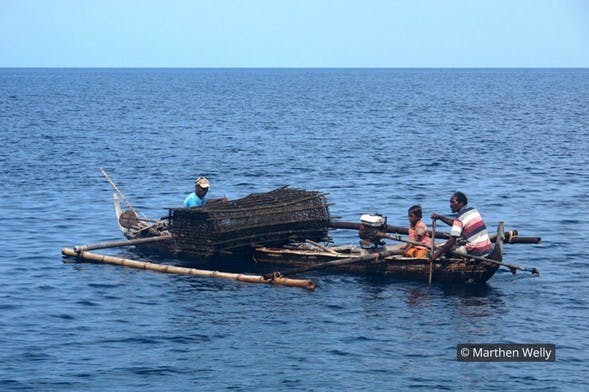| Grantee | Coral Triangle Centre ↗ |
| Type | Protected Areas |
| Grant Amount | $270,000 |
| Duration | Two Years |
Timor-Leste is part of Coral Triangle region with a total coastal and marine areas 77.474 km2 has unique coastal biodiversity resources and socio-economic characteristics (ADB, 2014; Boggs et al., 2012). Over 600,000 people who are living in Timor-Leste are highly dependent on these coastal and marine resources to support their livelihoods (UNDP, 2022). The biophysical and oceanographical setting somehow made the Timor-Leste water suitable as the foraging, nesting, and migrating area for many charismatic marine species including sea turtles, dugongs, cetaceans, sharks, and birds (ATSEA-2, 2022).
However, a variety of anthropogenic factors threaten marine resources in the ATS region, such as illegal, unreported and unregulated fishing; bycatch; unsustainable harvesting; and climate change. Globally threatened coastal marine megafauna including migratory, rare, and threatened species of turtles, dugongs, seabirds/shorebirds, sea snakes, cetaceans, sharks and rays are at risk. In addition, marine debris and pollution originating from maritime activities such as oil and gas exploration and extraction, fishing and shipping pose additional hazards to marine life (ATSEA2 PEMSEA 2020).
The coastal and marine resource management initiatives have helped Timor-Leste meet its national goals relating to food security and sustainable development of its fisheries resources, coral reefs, and related ecosystems. Under the global biodiversity framework “30 x 30” target, the Government of Timor-Leste has committed to protect 30% of its coastal and marine water through marine protected areas establishment. Marine Protected Areas (MPAs), particularly no-take zones (NTZs), can be powerful tools to address local threats and enhance fisheries productivity, protect biodiversity and increase ecosystem resilience to changes in climate and ocean chemistry (Green et al. 2014, 2019a). They can also enhance food security and sustainable livelihoods for communities and other stakeholders. MPA networks, collections of individual MPAs that are ecologically connected, can deliver additional benefits (e.g., by acting as mutually replenishing networks to facilitate recovery after disturbances: see review in Green et al. 2019a). However, MPAs and MPA networks can only achieve their objectives if they are well designed and effectively managed (Green et al. 2019b).
Nowadays, there are three existing MPAs in Timor-Leste legalized under the Ministerial Diploma (Nino Konis Santana, Atauro Island, Samba Sembilan Liquica) and two MPA candidates (Manufahi, Metinaro) with total area of 2.100 km2. It is covering about 3% of Timor-Leste waters. In terms of achieving “30 x 30” global commitment, Timor-Leste will need to more MPAs covering 63.000 km2 Regardless numbers and important function of MPAs for marine biodiversity protection and food security, remain crucial to focus on achieving management effectiveness of MPA. In Timor-Leste there is a lack of guidelines and support to achieve management effectiveness of MPAs based on science and local socio-economic characteristic such as Tara Bandu. National policy is needed to guide the MPA establishment and management. A tool also needs to be developed to measure the MPA management effectiveness in Timor-Leste. These national policies will provide clear guidance and legal support on MPAs establishment and management in Timor-Leste towards achieving national targets and global commitment.
Furthermore, we need to develop capacity building strategy to develop the human resources who can manage MPAs effectively. Boundary and zoning marking of MPAs, monitoring protocols are important to strengthen management of existing MPAs in Timor-Leste. CTC has been working for 10 years in Timor-Leste to support MPA establishment and management as well as the capacity building under an MoU with Ministry of Agriculture and Fisheries (MAF) of Timor-Leste. CTC in collaboration with MAF Timor-Leste, local community, NGOs, and University is facilitating MPAs establishment in Atauro Island MPA and Samba Sembilan Liquica MPA. These MPAs located in the north coast of Timor-Leste and legalized under Minister of Agriculture and Fisheries Decree recently in January 2023. Meanwhile continuing strengthening management of Atauro Island and Liquica MPAs, CTC also facilitating new MPAs establishment in Manufahi Municipality that located in the south coast and Metinaro in the north coast of Timor-Leste. As strategic partner, CTC works in Timor-Leste as part of implementation of CTI-CFF Regional Plan of Action (RPoA) and Timor-Leste National Plan of Action (NPoA)





















